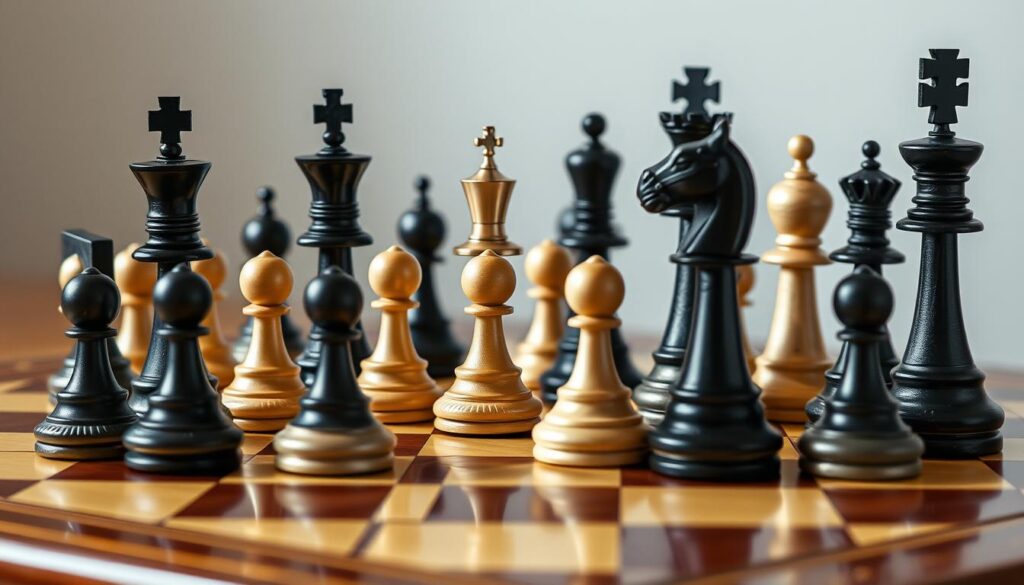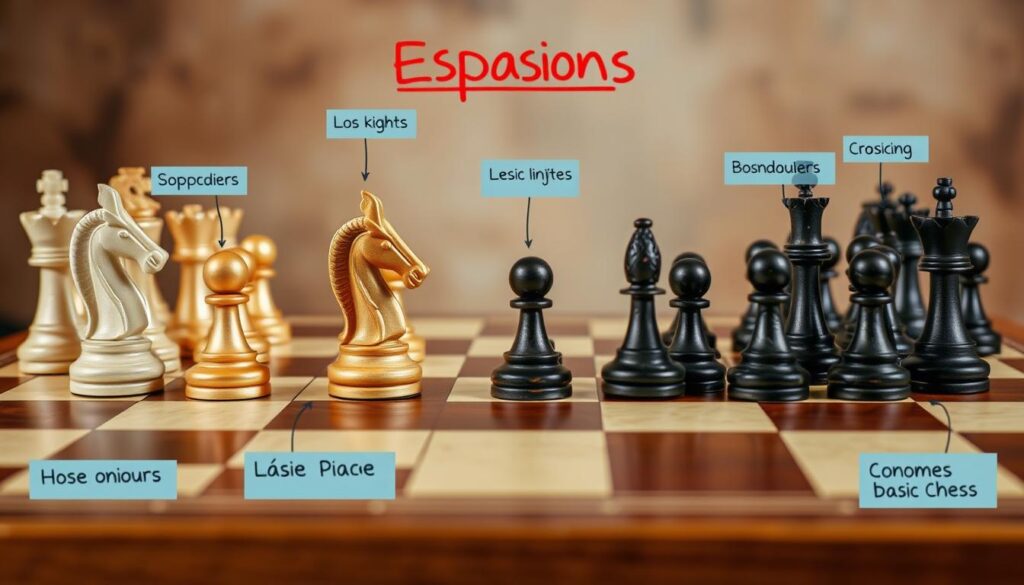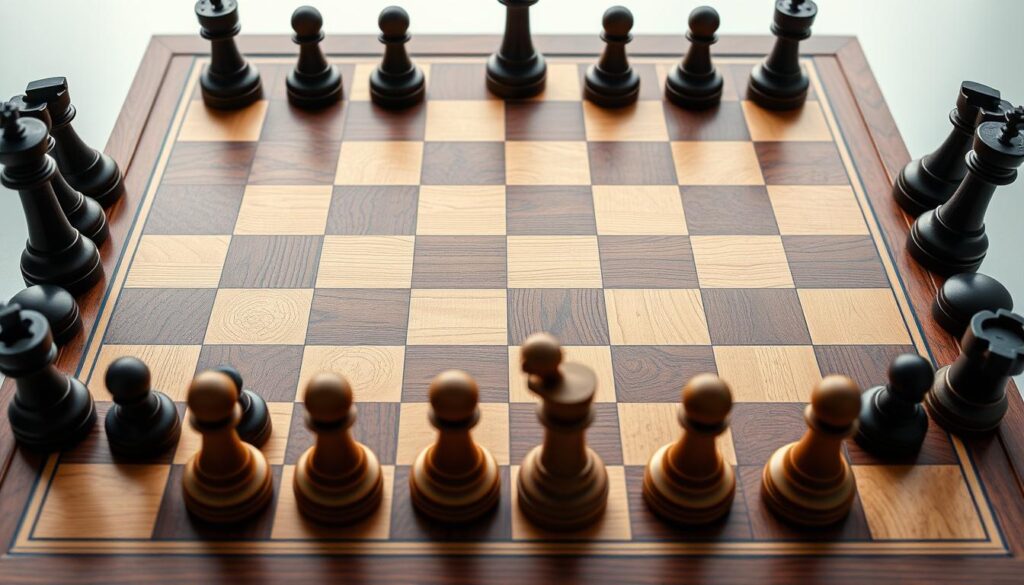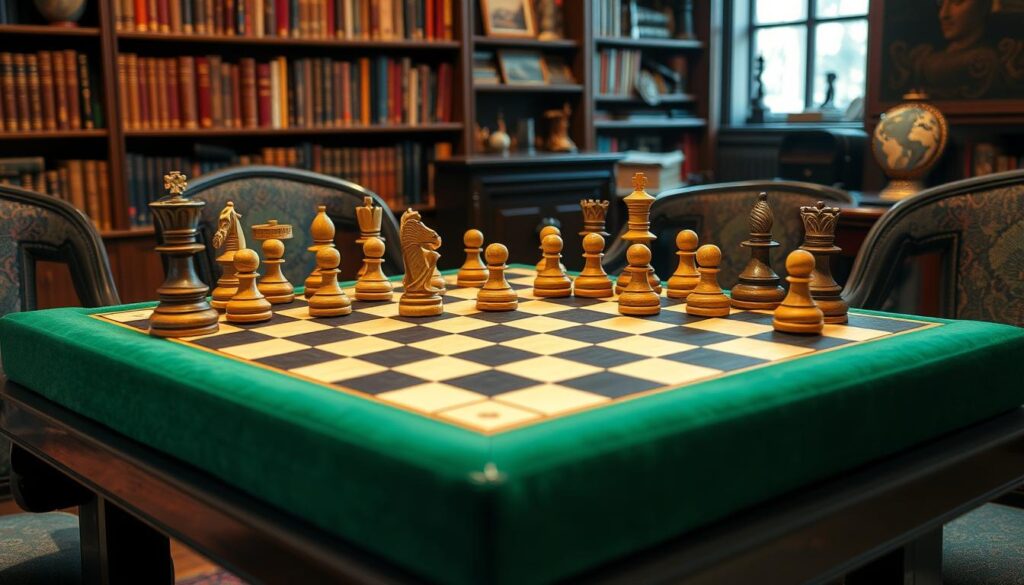Chess has always fascinated me with its mix of strategy, intellect, and culture. Exploring chess in spanish has been a new adventure. It has made me appreciate the game even more.
If you play chess in spanish or want to learn, this guide is for you. It will help you understand chess terms in Spanish. You’ll be able to join the global chess community, participate in tournaments, and dive into the game’s history and traditions.
Table of Contents
Understanding the Basics of Chess in spanish (Ajedrez)
Learning chess in spanish is exciting. Ajedrez, the Spanish word for chess, is a game that needs strategy, patience, and knowing the rules. It’s all about understanding how each piece moves on the board.
The goal of chess is to checkmate your opponent’s king. This means the king has no way to avoid being captured. To do this, you must know how each piece moves.
Chess pieces in spanish .
- El rey (The king)
- La reina (The queen)
- El alfil (The bishop)
- El caballo (The knight)
- La torre (The rook)
- El peón (The pawn)
Each piece has its own way of moving. Knowing these movements is key to playing well. For instance, the rey (king) can move one square in any direction. The peón (pawn) can only move forward, usually one square at a time.
Learning the basics of chess in spanish is the first step to more advanced skills. You’ll learn about jaque (check), jaque mate (checkmate), and enroque (castling). This knowledge will make you more confident in playing ajedrez and appreciate its history and strategy.

Whether you’re new to chess or already play, learning the basics in Spanish is rewarding. It opens doors to connect with chess fans worldwide. So, dive into the world of ajedrez and enjoy playing this timeless game in your chosen language.
Essential Chess Pieces and Their Spanish Names
Learning the Spanish names of chess pieces is key to playing the game in a new language. Each piece has its own role and way of moving. Knowing these basics helps you talk about the game and get better at it.
Let’s look at the main chess pieces and their Spanish names:
- Rey (King): The king is the most important piece. It can move one square in any direction. Its name, “Rey,” shows its key role in the game.
- Dama or Reina (Queen): The queen is the strongest piece. It can move any number of squares diagonally, horizontally, or vertically. Its names, “Dama” or “Reina,” mean it’s like a queen.
- Torre (Rook): The rook can move any number of squares horizontally or vertically. It’s strong for defense and attack. Its name, “Torre,” means “tower.”
- Alfil (Bishop): The bishop moves diagonally any number of squares. It’s flexible and controls key diagonal lines. Its name, “Alfil,” comes from Arabic for “elephant.”
- Caballo (Knight): The knight moves in an “L” shape. It moves two squares in one direction and then one square the other way. Its name, “Caballo,” means “horse.”
- Peón (Pawn): Pawns are the most common piece. Each player starts with eight. Though they seem weak, they can be very powerful. Their name, “Peón,” means “pawn” or “foot soldier.”
Knowing the Spanish names and how these pieces move is crucial. It helps you play better and talk about the game with others who speak Spanish. This way, you can improve your chess skills.

Chess in Spanish: Fundamental Game Terminology
Learning Spanish chess terms is key for players in Spanish-speaking areas. We’ll look at essential chess words in Spanish and their uses.
Moving a chess piece is called “Jugada” or “Movimiento” in Spanish. Capturing an opponent’s piece is “Capturar.” Saying your opponent’s king is in check is “Hacer jaque.” And checkmating the king is “Hacer jaque mate.”
“Enrocar” means castling, a defensive move. It helps the king stay safe and activates the rook. A draw in chess is called “Tablas.”
Knowing these basic terms in Spanish helps you talk with other players. It lets you dive deep into the chess game in spanish. Learning to how do you say chess in spanish opens up new chess experiences.
| Spanish Term | English Translation |
|---|---|
| Jugada or Movimiento | Move |
| Capturar | To capture |
| Hacer jaque | To check |
| Hacer jaque mate | To checkmate |
| Enrocar | To castle |
| Tablas | Draw |

The Chessboard Layout and Directions in Spanish
To fully grasp the game of chess in spanish translation, it’s key to know the chessboard layout and directions. The chessboard, called “Tablero de ajedrez” in Spanish, is a grid with 64 squares. It’s set up in an 8×8 pattern.
The board has vertical columns called “Archivos” and horizontal rows called “Filas.” These are numbered and lettered, making a coordinate system. For example, the bottom-left square is “A1” in Spanish.
- The center of the board is called the “Centro,” while the left and right areas are the “Flancos.”
- Diagonal movements are called “Diagonales.” Vertical and horizontal movements are “Verticales” and “Horizontales,” respectively.
Knowing these spanish opening in chess terms and the board layout is vital. It helps you navigate the game, plan strategies, and talk with your opponent in Spanish.

Special Moves and Advanced Terminology
As you explore chess in spanish, you’ll find special moves and advanced terms. These add depth and strategy to the game. Let’s dive into these concepts to improve your chess understanding.
En passant is a special pawn capture in Spanish. It happens when a pawn moves two squares forward and an opponent can capture it as if it moved one. In Spanish, this move is called Captura al paso.
Promoción (Promotion) is when a pawn reaches the opponent’s back rank. It can be exchanged for a more valuable piece, like a queen or knight. This move can change the game’s balance.
- Apertura (Opening): The game’s start, where players develop pieces and control the center.
- Mitad del juego or Medio juego (Middlegame): The game’s middle phase, where players use strategies to gain an advantage.
- Final or Fase final (Endgame): The game’s end, with few pieces left. Players must calculate and maneuver to win or draw.
Knowing these spanish opening in chess and bishop in spanish chess terms helps you play and talk chess with others in Spanish.
| Spanish Term | English Equivalent | Description |
|---|---|---|
| Captura al paso | En passant | A special pawn capture that occurs when a pawn moves two squares forward and an opposing pawn can capture it as if it had only moved one square. |
| Promoción | Promotion | When a pawn reaches the opponent’s back rank, it can be exchanged for a higher-valued piece, such as a queen, rook, bishop, or knight. |
| Apertura | Opening | The initial stage of the game, where players develop their pieces and establish control of the center. |
| Mitad del juego or Medio juego | Middlegame | The central phase of the game, where players execute their strategies and seek to gain an advantage. |
| Final or Fase final | Endgame | The final stage of the game, where only a few pieces remain, and players must accurately calculate and maneuver to achieve checkmate or a draw. |

Understanding Spanish Chess Notation
Playing chess in spanish-speaking countries means knowing the Spanish chess notation. This system uses special abbreviations and rules to record moves. It’s key to understanding the game.
In Spanish chess, each piece is named with its first letter in Spanish. For example, the king is “R,” the queen is “D,” and the rook is “T.” The bishop is “A,” and the knight is “C.” Pawns are shown by their square numbers.
- Piece Abbreviations:
- King (el rey): R
- Queen (la dama): D
- Rook (la torre): T
- Bishop (el alfil): A
- Knight (el caballo): C
- Pawn (los peones): Square coordinates
- Capturing Moves: The “x” symbol shows a capture, like “Txd5” (rook captures pawn on d5).
- Check and Checkmate: “+” means check, and “#” means checkmate, as in “R+d7” or “Dh8#.”
- Castling: It’s written as “O-O” for kingside and “O-O-O” for queenside.
- Pawn Promotion: Promoted pawns are shown, like “e8=D” (pawn on e8 becomes a queen).
Knowing Spanish chess notation helps you read and write chess games in Spanish. It also lets you annotate your games.
The Spanish chess notation is a great tool for players in Spanish-speaking countries. It deepens your understanding and love for chess in spanish translation.
Common Chess Strategies and Tactics in Spanish
Learning chess in spanish means more than just knowing the moves. You also need to grasp the complex strategies and tactics. Let’s dive into some key chess strategies and tactics in Spanish.
The Ruy Lopez, or “Apertura española,” is a classic chess opening. It has been around for over 500 years. This opening offers many variations and tactical chances for both players. The Spanish Game, as it’s called, has defenses like the Smyslov Defense, Bird’s Defense, and the Berlin Defense.
Chess strategy is about planning for the long term. Tactics, on the other hand, focus on quick, precise moves to get an edge. At the beginner and intermediate levels, tactics are crucial. They make up over 40% of the decisive games. Key tactics include tenedores (forks), alfileres (pins), and descubrimientos (skewers).
As players get better, they see these basic tactics less often. But, tactics remain key. Doing ejercicios tácticos (tactical exercises) regularly can boost your skill. This leads to higher chess ratings.
In Spanish chess, estrategia (strategy) and táctica (tactics) go hand in hand. Knowing both well is vital for success. By mastering common estrategias y tácticas in Spanish, you’re on your way to becoming a chess master.
| Spanish Term | English Equivalent |
|---|---|
| Apertura española | Ruy Lopez (Spanish Opening) |
| Defensa Smyslov | Smyslov Defense |
| Defensa Bird | Bird’s Defense |
| Defensa Berlín | Berlin Defense |
| Tenedor | Fork |
| Alfiler | Pin |
| Descubrimiento | Skewer |
| Ejercicios tácticos | Tactical Exercises |
| Estrategia | Strategy |
| Táctica | Tactic |
Practice Exercises and Learning Resources
To get good at chess in spanish, you need to practice. We’ll look at fun exercises and learning tools to boost your skills.
Let’s start with some fun practice exercises:
- Spanish chess puzzles: Try to find checkmates, forks, and other tactics using Spanish terms.
- Spanish chess mini-games: Play short games that test your Spanish chess knowledge.
- Spanish chess scenarios: Describe chess positions and outcomes in Spanish to improve your game.
There are many Spanish-language resources to help you get better at chess and Spanish:
- Chess books in Spanish: Read books on chess strategy, tactics, and how to play in Spanish.
- Spanish chess websites: Find online sites with chess lessons, tutorials, and forums in Spanish.
- Spanish chess apps: Use apps with Spanish puzzles, training, and games against other Spanish speakers.
These exercises and resources are great for beginners and experienced players. i play a lot of chess in spanish and become a chess master in Spanish.
| Resource | Description | Cost |
|---|---|---|
| ChessPlus ECU101 Training Course | The SMART Method to Teach Chess, recognized by the European Chess Union | €100 + €50 for the Certificate |
| ECU101 Training Courses Delivered | 79 courses as of November 2024 | N/A |
| ECU101 Graduates | More than 1,207 participants have acquired the ECU School Chess Teacher title | N/A |
| In-person ECU101 Courses Before Covid | 36 training courses held in 12 different countries | N/A |
| ECU101 Instructors | 9 instructors for the ECU101 – The SMART Method to Teach Chess | N/A |
| ECU101 Course Duration | Two days, from 10:00 to 17:00 CET | N/A |
| ECU101 Course Languages | English, with options for other languages provided | N/A |
| ECU101 Course Platform | ZOOM or InPerson | N/A |
| ECU101 Course Provider | ChessPlus, a contracted partner to ECU | N/A |
Conclusion
Learning the basics of chess in spanish is a big step. It opens up your chess world and connects you with players worldwide. You now know the chess pieces and their Spanish names. You also understand key game terms.
This journey has improved your chess skills and opened new doors. You can join Spanish chess tournaments, study strategies in Spanish, or talk with chess fans from Spain. Your knowledge in Spanish will make your chess experience richer.
Keep practicing and growing your Spanish chess vocabulary. This skill will make you appreciate chess more and connect with a wide chess community. Being able to play chess in different languages shows your dedication and the game’s global appeal.
FAQ
What is the Spanish word for chess?
The Spanish word for chess is “Ajedrez”.
How do you say the names of chess pieces in Spanish?
In Spanish, chess pieces are called: Rey (King), Dama or Reina (Queen), Torre (Rook), Alfil (Bishop), Caballo (Knight), and Peón (Pawn).
What are some basic chess actions and their Spanish translations?
Basic chess actions in Spanish include: Jugada or Movimiento (Move), Capturar (To capture), Hacer jaque (To check), Hacer jaque mate (To checkmate), Enrocar (To castle), and Tablas (Draw).
How is the chessboard layout described in Spanish?
The chessboard layout in Spanish is called Tablero de ajedrez. It includes terms for ranks, files, and diagonals. It also has directional terms like vertical, horizontal, and diagonal movements.
What are some Spanish terms for special chess moves and advanced concepts?
Spanish terms for special moves include En passant and Promoción (Promotion). Advanced concepts like Apertura (Opening), Mitad del juego or Medio juego (Middlegame), and Final or Fase final (Endgame) are also covered.
How does the Spanish chess notation system work?
The Spanish chess notation system uses abbreviations for pieces (R for Rey, D for Dama, etc.). It notates captures, checks, and special moves.
What are some common chess strategies and tactics in Spanish?
Common chess strategies and tactics in Spanish include Estrategia (Strategy), Tácticas (Tactics), Ataque (Attack), and Defensa (Defense). It also covers popular openings, middlegame plans, and endgame techniques.
Where can I find resources to practice and learn more about chess in Spanish?
The guide recommends Spanish-language chess resources. These include books, websites, and apps. They help players improve their chess skills and language proficiency at the same time.

















